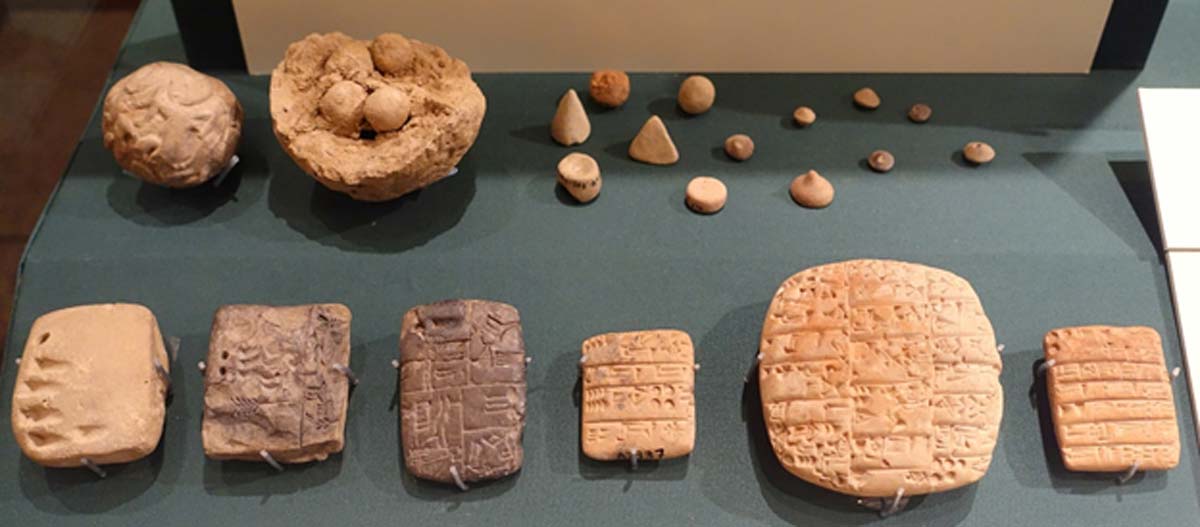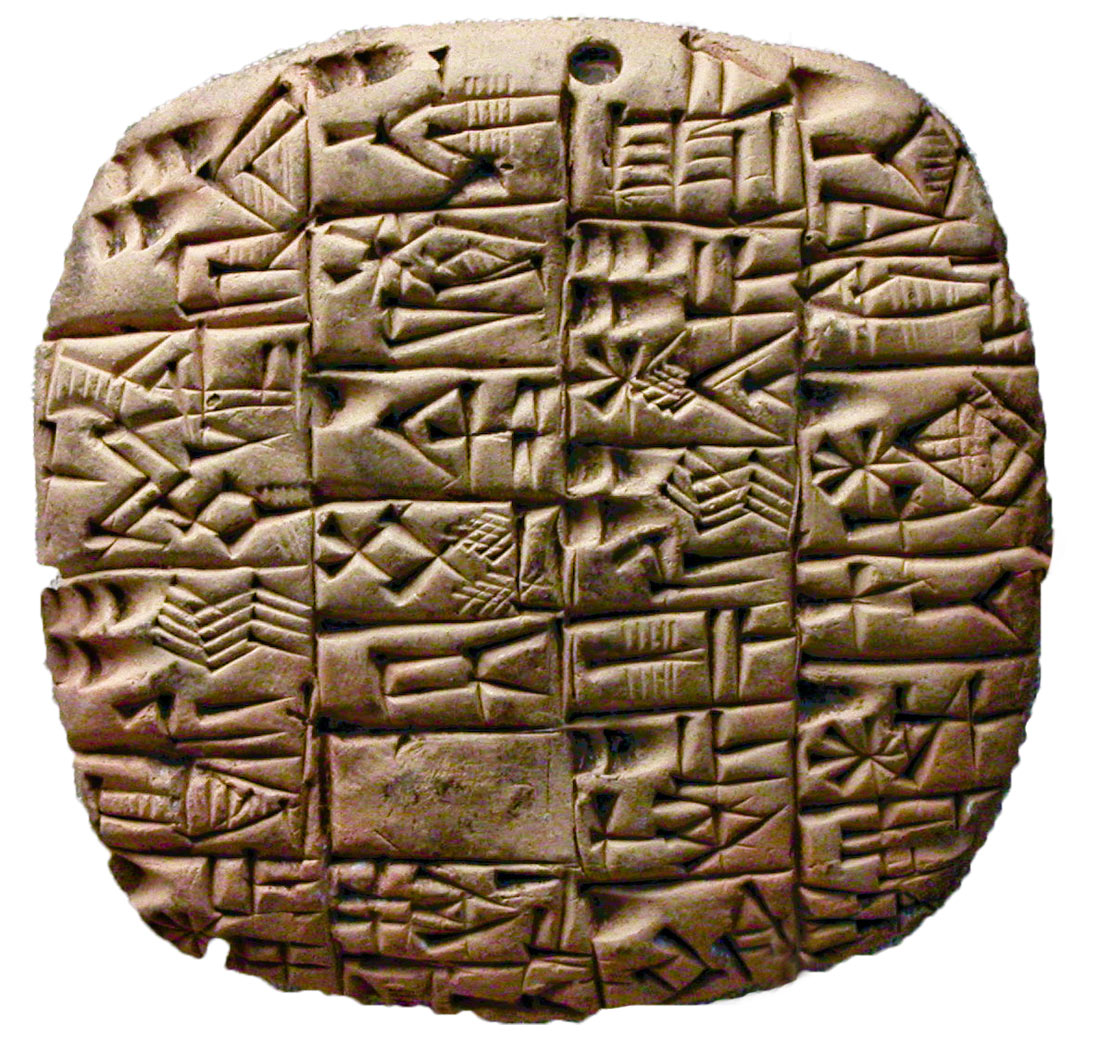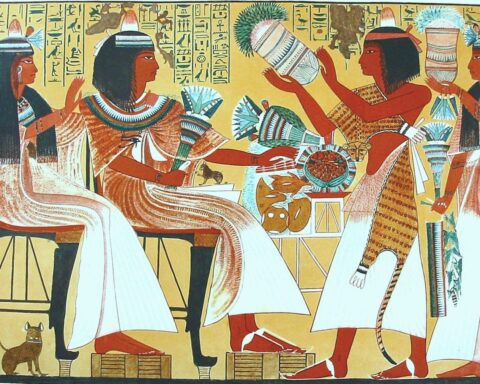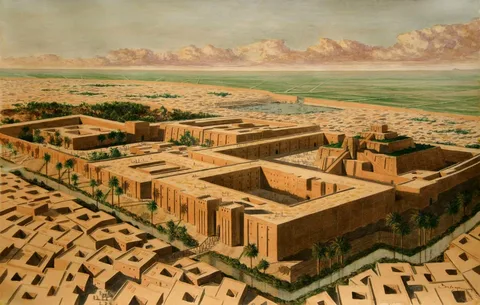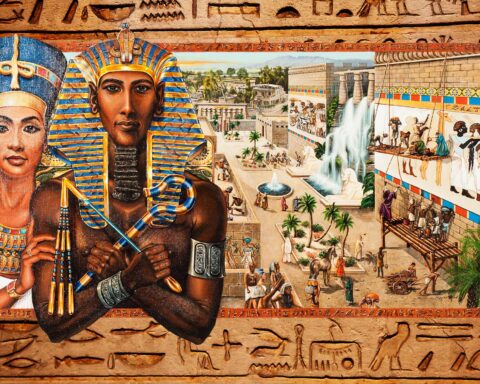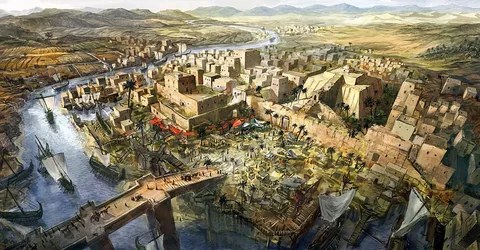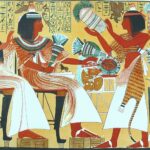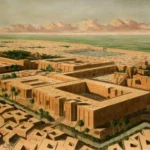The Origins of Ancient Mesopotamian Inventions
Early Developments in Writing Systems
The earliest developments in writing systems date back to ancient Mesopotamia, specifically to the region between the Tigris and Euphrates rivers in present-day Iraq. The invention of writing is believed to have occurred around 3500 BCE during the Uruk period (Uruk Dynasty), when people first started using tokens and symbols to represent objects and ideas.
The most significant innovation was the creation of Cuneiform, which emerged from the combination of logograms and phonetic signs. Cuneiform writing system, developed by the Sumerians, consisted of wedge-shaped characters that were inscribed on clay tablets with a reed stylus. This writing system enabled the recording of economic transactions, laws, and literature.
The first written texts from this period include administrative documents, such as receipts for goods and services, and literary works, like the Enuma Elish, which is an epic poem describing the creation of the world. The writing system was further developed by the Akkadians, Babylonians, and Assyrians, each contributing to its refinement and expansion.
The invention of cuneiform also facilitated the development of other crucial technologies, including:
Calendar
The ancient Mesopotamians created a sexagesimal (base-60) system for counting and recording time. This system is still used today in various forms, such as degrees and minutes on clocks.
Mathematics
The Babylonian Babylonian Plimpton 322, a clay tablet from around 1900 BCE, demonstrates advanced mathematical knowledge, including the Pythagorean theorem. This tablet is one of the oldest known examples of a math textbook in the world.
Surveying and Engineering
The Mesopotamians developed sophisticated irrigation systems, including canals and dams. Their understanding of geometry allowed them to design and build complex structures, such as temples and palaces.
The legacies of these ancient inventions continue to impact modern society in various ways:
Accounting: Modern accounting practices have their roots in the early recording systems developed by the Mesopotamians.
Literacy: The spread of written language enabled the transmission of knowledge and ideas, shaping the course of human history.
The first written language, cuneiform, emerged around 3200 BCE in ancient Sumeria.
The development of the first written language, cuneiform, is a significant milestone in human history. It emerged around 3200 BCE in ancient Sumeria, a civilization located in Mesopotamia (modern-day Iraq), which was one of the earliest urban centers of the world.
Cuneiform writing was created by the Sumerians to record business transactions, laws, and administrative documents. The name “cuneiform” comes from the Latin words for “wedge-shaped,” which refers to the distinctive shape of many cuneiform characters.
The invention of cuneiform marked a turning point in human communication, as it allowed people to convey complex ideas and stories over long distances. This technology had a profound impact on the development of civilization, enabling the creation of written records that could be passed down through generations.
Cuneiform writing was used by the Sumerians for over 3,000 years, with its use eventually spreading to other civilizations in Mesopotamia. The language itself was used as a means of communication between different city-states and empires, facilitating trade, diplomacy, and cultural exchange.
The invention of cuneiform also laid the foundation for future writing systems. Its logographic nature, where symbols represented words or concepts rather than sounds, influenced the development of other writing systems, such as Egyptian hieroglyphics and Chinese characters.
The use of cuneiform has had a lasting impact on human history. It has allowed us to study the cultures and achievements of ancient civilizations, providing valuable insights into their social, economic, and political structures. Cuneiform texts have also shed light on our understanding of mathematics, astronomy, medicine, and literature, among other fields.
Many cuneiform tablets have survived to this day, providing a tangible connection to the past. These ancient documents offer a unique window into the lives of people who lived thousands of years ago, offering insights into their daily experiences, customs, and traditions.
The study of cuneiform writing has also led to significant discoveries in fields such as archaeology and linguistics. Cuneiform scholars have uncovered new knowledge about the history of writing itself, shedding light on the evolution of languages and the development of writing systems worldwide.
This innovation allowed for the recording of laws, business transactions, and literature.
This innovation allowed for the recording of laws, business transactions, and literature by enabling the creation of written records that could be used to convey information over long distances.
The invention of writing had a profound impact on ancient Mesopotamian society, allowing for the development of more complex systems of governance, commerce, and culture.
For example, the Code of Hammurabi is one of the most well-known examples of written laws from ancient Mesopotamia, and it demonstrates the importance of writing in recording legal codes and standards.
The invention of writing also facilitated the development of business transactions, as merchants could use written records to keep track of trade goods, prices, and debts. This allowed for more complex economic systems to emerge, including the use of credit and financial instruments.
Furthermore, the recording of literature enabled ancient Mesopotamian writers to express themselves in new ways, experimenting with form and style as they composed epic poems, hymns, and other literary works.
The most significant innovation that allowed for these developments was likely the invention of cuneiform writing around 3500 BCE. This script consisted of wedge-shaped marks inscribed on clay tablets using a reed stylus.
Cuneiform writing enabled the recording of laws, business transactions, and literature in a way that was both durable and accessible to large numbers of people. It also facilitated the development of more complex systems of governance, commerce, and culture in ancient Mesopotamia.
The use of cuneiform writing had far-reaching consequences for ancient Mesopotamian society, including the creation of written records of laws, business transactions, and literature that continue to be studied by scholars today. The impact of this innovation can still be seen in modern times, as we continue to adapt and refine our systems of communication, governance, and culture.
In conclusion, the invention of writing in ancient Mesopotamia revolutionized the way people recorded laws, business transactions, and literature, enabling the creation of complex systems of governance, commerce, and culture that persist to this day. The use of cuneiform writing was a significant innovation that had far-reaching consequences for ancient society, and its impact can still be felt in modern times.
The study of these innovations highlights the importance of adapting and refining our systems of communication, governance, and culture as we move forward into the future. By understanding how ancient civilizations developed complex societies, we can learn valuable lessons about the importance of recording laws, business transactions, and literature in written form, and the impact that this has on society as a whole.
The Impact on Agriculture and Food Production
Irrigation Systems: A Key to Mesopotamian Prosperity
The ancient civilization of Mesopotamia, which thrived between the Tigris and Euphrates rivers, is often referred to as the cradle of civilization. One of the key factors that contributed to their prosperity was the development of sophisticated irrigation systems.
Mesopotamian farmers were able to cultivate crops in a region with limited rainfall by constructing elaborate networks of canals, dikes, and dams to control water flow. This allowed them to bring fertile silt from the rivers into the fields, creating arable land for farming.
The ancient Mesopotamians also developed innovative irrigation methods that included the use of qanats – subterranean canals that tapped into underground water sources – as well as surface canals and dams. These systems enabled farmers to irrigate crops throughout the year, even in areas where rainfall was scarce.
The Sumerian city of Ur is an excellent example of a Mesopotamian irrigation system. The ancient Sumerians built a network of canals, including the famous Wadi Ukhaidar canal, which brought water from the Euphrates to the city’s fields and gardens.
These advanced irrigation systems allowed the Mesopotamians to develop agriculture in a region where it might have otherwise been impossible. By cultivating crops such as barley, wheat, and dates, they were able to establish cities and support large populations, laying the foundation for one of the most influential civilizations in history.
The significance of Mesopotamian irrigation systems extends far beyond ancient times. Many of the technological innovations developed by these early civilizations are still used today in various forms. For example, the concept of qanats has been adopted and modified in modern underground water supply systems around the world.
Furthermore, the use of surface canals and dams continues to be a critical component of modern irrigation systems in regions where rainfall is scarce. In fact, the Sumerian system of canals and dikes is still studied by engineers today for its ingenuity and effectiveness.
The Mesopotamian innovations that have stood the test of time are a testament to human ingenuity and resourcefulness in the face of adversity. By learning from our ancestors’ achievements, we can continue to improve upon their ideas and create even more effective systems for managing water resources – a crucial aspect of sustaining life on Earth.
The invention of irrigation systems enabled the cultivation of crops in areas with limited natural water supply.
The invention of irrigation systems
revolutionized agriculture by enabling the cultivation of crops in areas with limited natural water supply. This breakthrough had a profound impact on human history, allowing for the growth of settlements and civilizations that were previously impossible due to lack of access to water.
In ancient Mesopotamia, also known as the Fertile Crescent, irrigation systems played a crucial role in the development of agriculture. The region’s fertile soil and suitable climate made it an ideal place for farming, but without irrigation, crops would not have been able to grow.
The ancient Mesopotamians developed sophisticated irrigation canals, which allowed them to channel water from rivers and streams into their fields. These canals were often built with the help of engineering expertise
and required a great deal of planning and labor to construct.
The use of irrigation systems in ancient Mesopotamia enabled the cultivation of crops such as wheat, barley, and dates. These crops became staples of the Mesopotamian diet and played a crucial role in the development of their society.
One of the most impressive examples of ancient Mesopotamian irrigation
is the ancient city of Babylon’s Ishtar Canal. This canal, built around 1900 BCE, was a remarkable feat of engineering that allowed water to be channeled from the Euphrates River into the heart of the city.
The invention of irrigation systems had far-reaching consequences for human history. It enabled the growth of settlements and civilizations, allowing people to move away from nomadic lifestyles and settle in permanent locations. This, in turn, led to the development of more complex societies, with specialized labor, social hierarchies, and eventually, the emergence of cities.
Today, irrigation systems
remain a crucial part of modern agriculture, allowing crops to be grown in areas with limited natural water supply. While many of the ancient Mesopotamian irrigation systems have been lost to time, their legacy lives on in the modern systems that continue to enable crop cultivation around the world.
The study of ancient Mesopotamian inventions, including irrigation systems, continues to fascinate historians and archaeologists. By studying these ancient civilizations, we can gain a deeper understanding of how human societies developed and evolved over time, and what lessons we can learn from their achievements and failures.
In conclusion, the invention of irrigation systems
was a pivotal moment in human history, enabling the cultivation of crops in areas with limited natural water supply. Ancient Mesopotamian inventions, including irrigation systems, continue to influence modern society, reminding us of the ingenuity and creativity of our ancestors.
This breakthrough allowed for increased food production and supported growing populations.
The ancient Mesopotamians are known to have made significant contributions to the development of civilization, with many of their inventions still being used today. One such breakthrough was the discovery of irrigation systems, which allowed for increased food production and supported growing populations.
This innovation is particularly noteworthy in the context of the region’s arid climate and limited fertile land. By constructing canals, dams, and reservoirs to store water, the Mesopotamians were able to cultivate crops that would not have been viable otherwise.
The effects of this breakthrough were far-reaching, allowing for a significant increase in food production and enabling populations to grow rapidly. This, in turn, contributed to the development of larger cities and more complex societies.
Another important invention credited to the ancient Mesopotamians is the plow. This simple yet effective tool allowed farmers to cultivate and till soil with greater ease, resulting in higher crop yields and increased food production.
The introduction of the wheel also had a profound impact on agriculture, as it enabled the creation of more efficient irrigation systems and facilitated the transportation of goods, including grains and other crops.
These ancient inventions continue to be used today, with modern farming relying heavily on techniques such as crop rotation and irrigation. In fact, many of the world’s most productive farms still employ similar methods developed by the Mesopotamians thousands of years ago.
The significance of these discoveries cannot be overstated, as they paved the way for the development of agriculture on a large scale. This, in turn, allowed for the growth of cities and civilizations, which would eventually lead to the modern world we know today.
Early Forms of Plowing and Farming Equipment
The earliest forms of plowing and farming equipment date back to ancient civilizations, with the Mesopotamians being one of the first to develop sophisticated tools for agriculture.
Mesopotamian Inventions
The Sumerians, Babylonians, and Assyrians all made significant contributions to the development of farming equipment. They used simple tools made from wood, stone, and bone to cultivate crops such as barley, wheat, and dates.
Some of the earliest forms of plowing equipment include
The ard: A primitive plow that was used by the ancient Mesopotamians around 4000 BCE. The ard had a simple frame with two wooden plows attached to it, which were pulled behind an ox.
The scratch plow: Developed by the ancient Greeks and Romans, this type of plow was used to loosen soil and create furrows for planting seeds.
These early forms of plowing equipment were not only used for agriculture but also for other purposes such as clearing land, making roads, and even warfare.
The ancient Mesopotamians also developed other important farming tools, including:
Hoe: A simple tool with a blade attached to it that was used for weeding and cultivating crops.
Harvesting sickles: Used for cutting grains and other crops during harvest season.
The legacy of these ancient inventions can still be seen today, with many modern farming equipment being designed with similar principles in mind. Modern plowing equipment has come a long way since its ancient counterparts, but the basic idea remains the same: to cultivate soil and plant crops efficiently.
The use of plows and other farming equipment improved crop yields and facilitated largescale agriculture.
The use of plows and other farming equipment significantly improved crop yields and facilitated large-scale agriculture, revolutionizing the way people produced food and shaped the course of human history.
In ancient Mesopotamia, which is now modern-day Iraq, farmers developed and utilized a range of innovative tools that enabled them to cultivate and harvest crops on a larger scale.
One of the most significant inventions was the plow, which allowed farmers to break up and prepare the soil for planting. The early plows were typically made from wood or bone and consisted of a curved blade attached to a long handle.
The introduction of the iron plow in ancient Mesopotamia marked a major turning point in agricultural history. Iron-plowed fields could be cultivated more efficiently, allowing farmers to plant crops at different times of the year and increasing overall crop yields.
Other important farming equipment developed by ancient Mesopotamians included:
The ox-drawn plow: This innovation allowed farmers to cultivate larger areas of land than ever before.
Irrigation systems: These enabled farmers to control the flow of water and ensure that crops received a steady supply, even in times of drought.
Harrows: These tools were used to break up clods and smooth out the soil after plowing, making it easier for seeds to germinate.
The use of these farming equipment and other inventions enabled ancient Mesopotamians to produce a surplus of food, which in turn supported the growth of cities and the development of more complex societies.
Many of these innovations have had a lasting impact on agriculture and continue to be used today. The iron plow, for example, remains an essential tool for farmers around the world, while irrigation systems are used to support crops in regions where rainfall is scarce.
The legacy of ancient Mesopotamian farming technology can also be seen in modern precision agriculture techniques, which rely on advanced computer and sensor systems to optimize crop yields and reduce waste.
These innovations contributed to the growth of cities and the development of complex societies.
The ancient Mesopotamians were known for their innovative spirit, which led to the creation of various technologies that played a crucial role in the growth and development of cities. One of the most significant contributions was the invention of the wheel, which revolutionized transportation by allowing people to move goods and materials more efficiently.
The wheel’s impact was felt far beyond just transportation. It enabled the construction of roads, bridges, and other infrastructure that facilitated the movement of people and goods across long distances. This, in turn, contributed to the growth of cities, as people were able to travel more easily and trade goods with one another.
Another innovation that had a significant impact on city development was the invention of irrigation systems. By allowing crops to be watered efficiently, these systems enabled farmers to grow a wide range of crops, including grains and vegetables. This led to an increase in food production and helped support the growth of cities by providing a steady supply of sustenance.
The ancient Mesopotamians also developed sophisticated writing systems, which played a crucial role in the development of complex societies. Writing enabled people to record laws, trade agreements, and other important documents, facilitating communication and cooperation across long distances.
In addition, the invention of advanced metallurgy allowed for the production of metal tools and weapons, leading to an increase in agricultural productivity and military power. This further contributed to the growth of cities and the development of complex societies, as people were able to produce more food and protect themselves from external threats.
Finally, the Mesopotamians’ innovative spirit led to the creation of sophisticated systems for governance, including laws, bureaucracies, and administrative systems. These allowed for the efficient administration of cities and the management of complex societies, enabling leaders to make informed decisions and implement policies that promoted the well-being of their citizens.
These innovations had a lasting impact on human history, as they laid the foundations for modern urbanization and the development of complex societies. They demonstrate the power of innovation and the importance of investing in technologies that promote growth, productivity, and cooperation.
The Emergence of Mesopotamian Urban Planning and Architecture
The Design of Ziggurats: Temples and Centers of Worship
The design of ziggurats, ancient Mesopotamian temples, has been a subject of fascination for centuries. These towering structures were not only centers of worship but also architectural marvels that reflected the advanced engineering skills and artistic expression of their creators.
Ziggurats were typically built in the shape of stepped pyramids, with each level representing a different zone of the universe. The most famous example, the Great Ziggurat of Ur, was built by King Ur-Nammu around 2100 BC and features seven levels that ascend to a height of over 64 feet.
The design of ziggurats served several purposes beyond mere architecture. They were considered sacred spaces where kings could connect with their gods, making offerings and seeking guidance for the welfare of their people. The stepped pyramid shape allowed for easy access to each level, while also creating a sense of hierarchy and order that reflected the social structure of ancient Mesopotamian society.
Another key feature of ziggurat design was the use of ramps and stairs to facilitate the transport of materials and workers during construction. This innovative approach allowed for the building of large structures without the need for complex machinery, showcasing the ingenuity of ancient Mesopotamian engineers.
Ziggurats also served as centers of education, where priests and scribes could study and record important texts. The temple’s library and scriptorium contained valuable knowledge about astronomy, mathematics, and medicine, which were often inscribed on clay tablets for preservation and dissemination.
Today, the legacy of ziggurat design can be seen in various forms of architecture around the world, from modern skyscrapers to ancient temples. Their stepped pyramid shape has become an iconic symbol of ancient Mesopotamian culture, inspiring admiration and curiosity among archaeologists, architects, and enthusiasts alike.
The study of ziggurats continues to provide valuable insights into the social, cultural, and economic dynamics of ancient societies. By examining their design and construction, researchers can gain a deeper understanding of the values and priorities that guided these early civilizations, as well as the technological advancements that enabled them to build such impressive structures.
The influence of ziggurat design extends far beyond the realm of architecture, with its legacy visible in art, literature, and even politics. From the pyramids of Egypt to the skyscrapers of modern cities, the concept of verticality has become an enduring symbol of human ingenuity and ambition.
Ziggurats, multitiered temples, were built as centers of worship for various citystates.
The Ziggurat, a multitiered temple, was a central architectural feature of ancient Mesopotamia. These towering structures were built as centers of worship for various city-states, serving as hubs for religious and civic activities.
Origins of the Ziggurat
The concept of the Ziggurat emerged in the 4th millennium BC, during the Sumerian civilization. The first known example is the Temple of E-Anna at Uruk, built by King Ur-Nammu around 2100 BC.
Design and Layout
A typical Ziggurat consisted of a series of tiered platforms, often aligned with the cardinal directions (east-west, north-south). These platforms were typically made of mud-brick or stone, with a stepped pyramid-like design. The outer walls featured ornate carvings and glazed tiles.
The Ziggurat’s layout was symbolic of the mythological Mountain of Creation, believed to be the site where the gods created humans.
Purpose and Function
These colossal structures served as the focal point for city-state worship. They housed various shrines, temples, and altars dedicated to a particular deity or pantheon of deities. Priests and priestesses officiated rituals, performed sacrifices, and offered prayers on behalf of the city’s inhabitants.
The Ziggurat was also an administrative center, where laws, decrees, and edicts were promulgated by the ruler or high priests.
Examples of Ancient Mesopotamian Inventions Still Used Today
The Ziggurat’s design innovations have had lasting impacts on modern architecture. For instance:
The use of mud-brick construction and stepped pyramids influenced the development of ancient Greek temples, such as the Parthenon.
The concept of a multitiered structure has been employed in numerous buildings worldwide, including skyscrapers and public monuments.
Cultural Legacy
Today, the Ziggurat remains an iconic symbol of ancient Mesopotamian culture, inspiring awe and curiosity about our shared human history. Their legacy can be seen in modern architecture, engineering, and cultural traditions that continue to evolve.
These structures often served as symbols of power and prestige.
The ancient civilizations of Mesopotamia, which corresponds to modern-day Iraq, Kuwait, and parts of Syria, Turkey, and Iran, made significant contributions to the development of human societies. Their innovative architectural structures often served as symbols of power and prestige, reflecting the wealth, status, and influence of their builders.
One such structure is the ziggurat, a type of stepped pyramid that was used by the ancient Sumerians, Akkadians, Babylonians, and Assyrians to honor their gods. These towering structures were often decorated with intricate carvings and sculptures, showcasing the artistic and engineering skills of the Mesopotamians.
Ziggurats served as centers of worship, where priests would perform rituals and sacrifices to appease their gods. They also functioned as symbols of power, demonstrating the wealth and influence of their builders. The largest ziggurat in Mesopotamia was the Great Ziggurat of Ur, built by King Ur-Nammu around 2100 BC.
Another structure that symbolized power and prestige is the palace. In ancient Mesopotamia, palaces were grand structures that served as residences for kings and other high-ranking officials. They were often decorated with luxurious furnishings, artwork, and gardens, reflecting the wealth and status of their occupants.
The most famous palace in Mesopotamia is the Palace of Nebuchadnezzar II at Babylon, built around 600 BC. This impressive structure featured stunning architecture, including the famous Ishtar Gate, which was adorned with images of dragons and lions. The palace also boasted extensive gardens and a series of temples dedicated to the gods.
The ancient Mesopotamians were also skilled engineers who developed innovative technologies that have had lasting impacts on modern society. One example is the invention of the wheel, which revolutionized transportation and trade in the region. Another innovation was the development of irrigation systems, which enabled the growth of crops in areas with limited rainfall.
Today, we continue to use many of the inventions developed by the ancient Mesopotamians. The wheel has become a ubiquitous feature of modern technology, from bicycles to automobiles. Irrigation systems are still used worldwide to support agriculture and ensure food security.
The ziggurats may no longer stand tall, but their legacy lives on in the many architectural structures that have been inspired by them. From ancient temples to modern skyscrapers, we continue to draw inspiration from the innovative designs of our ancestors.
As we look back at the achievements of the ancient Mesopotamians, we are reminded of the importance of innovation and creativity in shaping human societies. By embracing new technologies and pushing the boundaries of what is possible, we can continue to build on the foundations laid by our predecessors and create a brighter future for all.
Early Examples of City Planning and Urban Design
The earliest examples of city planning and urban design can be seen in the ancient civilizations of Mesopotamia, particularly in modern-day Iraq and Kuwait. The Mesopotamians were skilled architects and engineers who developed sophisticated systems for managing water, sewage, and waste disposal.
One of the most impressive achievements of ancient Mesopotamian city planning was the creation of the grid system, which is still used today in many cities around the world. This system involves dividing a city into rectangular blocks or streets that are intersected by other streets at right angles, creating a grid-like pattern.
The ancient Mesopotamians also developed a sophisticated system for managing water resources, including canals and aqueducts that brought fresh water to the cities from surrounding rivers and lakes. This system allowed for the growth of large populations and enabled the development of agriculture and industry.
Another example of ancient Mesopotamian innovation is the invention of the sewage system. The Sumerians developed a complex network of pipes and tunnels that carried waste away from homes and businesses, creating a clean and healthy environment for the population.
The ancient Mesopotamians also made significant advances in urban design, including the creation of public spaces such as parks and gardens, which provided recreation and relaxation for the citizens. The city of Babylon, built by the Neo-Babylonian Empire in the 6th century BCE, is famous for its beautiful gardens and courtyards.
Today, many modern cities around the world still use the grid system developed by the ancient Mesopotamians. This includes cities such as New York, Chicago, and San Francisco in the United States, as well as cities in Europe and Asia.
In addition to city planning and urban design, the ancient Mesopotamians made significant contributions to modern technology, including the invention of the wheel, which is still used today in many forms. The wheel was first developed by the Sumerians around 4000 BCE and was initially used for transportation, but later became a key component of machines such as the windmill and waterwheel.
The ancient Mesopotamians also made significant advances in metallurgy, including the development of bronze tools and techniques that are still used today. The Babylonians developed a sophisticated system for casting bronze artifacts, which included the creation of intricate designs and ornaments.
The planning and design of cities, such as Babylon and Nineveh, showcased advanced engineering and architectural skills.
The planning and design of cities like Babylon and Nineveh showcased advanced engineering and architectural skills.
Babylon, the capital of the Neo-Babylonian Empire, was a major urban center that boasted impressive infrastructure and architecture. Its city plan featured a sophisticated system of canals, streets, and public buildings, demonstrating the ingenuity of its builders.
The Ishtar Gate, one of the gates of Babylon’s city walls, is particularly notable for its design and construction. The gate was adorned with images of dragons and bulls, symbolizing the gods Marduk and Adad, respectively.
Another impressive aspect of Babylonian urban planning was its use of arches and vaults to support structures, which enabled builders to create larger and more complex spaces without the need for columns or other supports. This innovation is still used today in modern architecture.
Nineveh, on the other hand, was a major city in Assyria, known for its impressive palace complexes and fortifications. The city’s layout featured a series of concentric walls, with the innermost wall containing the royal palace and surrounding gardens.
The Hanging Gardens of Nineveh, one of the Seven Wonders of the Ancient World, were said to be built by King Sennacherib for his wife, Queen Amytis. The garden’s design featured a complex system of arches and aqueducts that brought water from the nearby mountains to create lush vegetation.
One of the most significant ancient Mesopotamian inventions still used today is the concept of the “standard” unit of measurement, which was developed by the Babylonians. They divided the circle into 360 degrees, with each degree consisting of 60 minutes and each minute composed of 60 seconds.
The concept of standardization has had a profound impact on modern society, enabling precise measurements in various fields such as engineering, architecture, navigation, and more.
Another important invention from ancient Mesopotamia is the wheel, which revolutionized transportation and trade. The wheel’s design consisted of a circular frame with spokes connecting the hub to the rim, allowing for easy rotation and movement.
Today, the wheel remains an essential component in various forms, including cars, trucks, airplanes, bicycles, and other vehicles, as well as in machinery and industrial equipment.
These urban centers featured public spaces, markets, and other civic amenities that supported the needs of citizens.
The cities of ancient Mesopotamia, which was situated between the Tigris and Euphrates rivers in modern-day Iraq, played a crucial role in shaping human civilization. The urban centers that emerged in this region featured public spaces, markets, and other civic amenities that supported the needs of citizens.
One of the most significant innovations of ancient Mesopotamia was the development of irrigation systems, which allowed for the cultivation of crops in fertile areas with abundant water supply. This technological advancement enabled the population to increase dramatically, as people were no longer limited by the availability of arable land.
The invention of the wheel is another Mesopotamian innovation that continues to be used today. The wheel revolutionized transportation and trade, making it possible for goods to be transported over long distances with greater ease and efficiency. The wheel also facilitated the development of other technologies, such as pottery-making and metallurgy.
Another ancient Mesopotamian invention that is still in use today is the system of writing, which was developed by the Sumerians around 3,500 BCE. This system of written communication allowed for the recording of laws, business transactions, and historical events, making it possible to preserve knowledge and cultural heritage over time.
The development of cities also led to the creation of specialized labor and social hierarchies, with distinct classes of artisans, merchants, and officials emerging in response to the needs of urban centers. The growth of cities facilitated the exchange of goods and ideas across different regions, laying the foundation for the modern global economy.
The civic amenities that supported citizens in ancient Mesopotamian cities included public spaces such as temples, palaces, and markets. These spaces served multiple purposes, including worship, governance, commerce, and entertainment. The existence of these civic amenities helped to foster a sense of community and social cohesion among the population.
Overall, the urban centers of ancient Mesopotamia featured a range of public spaces, markets, and civic amenities that supported the needs of citizens. These innovations laid the foundation for modern civilization and continue to have a lasting impact on our daily lives today.
- Austin, Texas - September 4, 2024
- Country Flags With Stars - September 4, 2024
- 7 Oldest Cities In The United States - September 4, 2024

